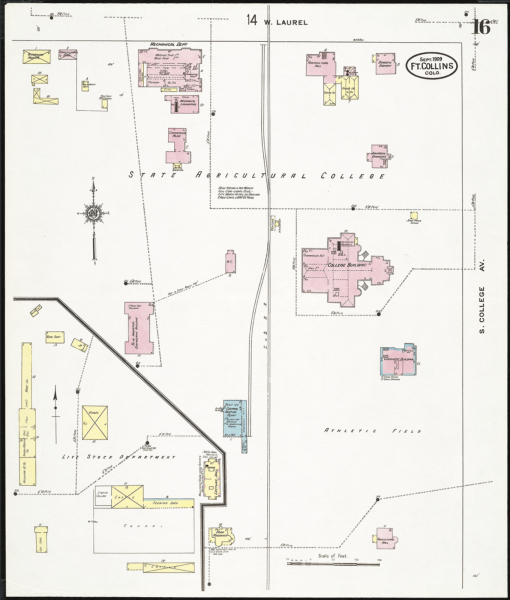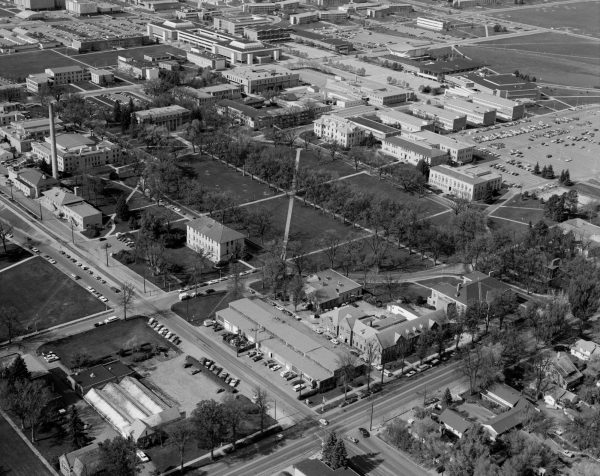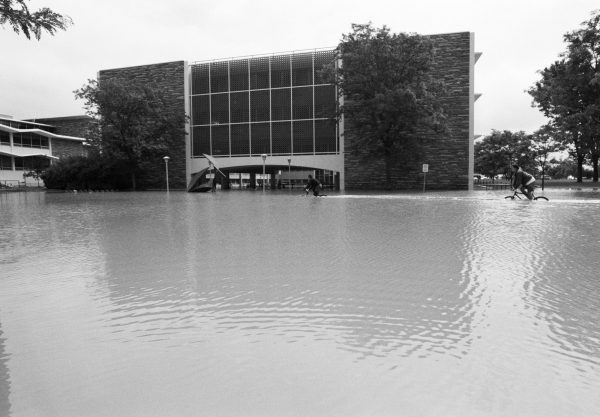James E. Hansen II
September 27, 2019
For CSU’s 150th anniversary, the History Department invited Professor Emeritus, James Hansen to reflect on the history of this institution. He draws on his experiences teaching at CSU and over forty years of research. We asked him to choose three moments that defined this university. Here is what he chose.
CSU: 150 years—A Historian’s Perspective
Most of my professional life has encompassed researching, preserving, and writing about CSU’s past. I came Fort Collins in 1966 with a background in the history of higher education, and six years later, initiated a project that resulted in an institutional archive and a comprehensive study, Democracy’s College in the Centennial State (1977). More than a dozen publications ensued, often in collaboration with graduate students; and in 1981, I began providing a historical essay for commencement ceremonies. This scholarly activity involved individual program, college, outreach, and campus developments, which usually included chronological milestones.
In order to refute the admonition that “history is just one damn thing after another,” I typically organized CSU’s past into identifiable periods. The sesquicentennial anniversary provides a singular opportunity to highlight selected examples.
The Pioneer Era (1870-1909)
February 11, 1870: Territorial governor of Colorado, Edward M. McCook, signs legislation establishing a Morrill Act college at Fort Collins.
At the same time that the American Civil War plummeted the nation into turmoil over the issue of slavery, settler travel along the Overland Trail caused conflict with Indigenous peoples who sought to limit the number of incursions into their treaty territories. The federal government established a military post (officially named Fort Collins on October 23, 1864) to protect mail service and travelers journeying west. This facility constituted a major economic catalyst for the region. Meanwhile, in 1862 President Abraham Lincoln authorized the Morrill Act, which provided federal land grants to support institutions of higher learning that offered instruction in agriculture and the mechanic arts and “the liberal and practical education of the industrial classes in the several pursuits and professions of life.” It was intended to promote a new kind of higher education—one that provided access to citizens of all classes, including women, and emphasized practical training that might lead to useful employment.
In 1867, the fort was abandoned, and local citizens wondered: how will our community survive without it? Harris Stratton, a local businessman and politician, recognized the Morrill Act as an opportunity to restore prosperity and, with other boosters, successfully lobbied the Colorado territorial legislature to designate Fort Collins as the site for the college. Thus began a town and gown connection that would continuously impact the school’s history.
The William E. Morgan Era (1949-1969)
May 1, 1957: The school is renamed Colorado State University. 
After World War II CSU underwent a massive enrollment expansion. Cold war tensions led to vastly augmented federal support for scientific research and training that promoted sponsored projects and graduate education. Scores of new facilities that included dormitories, classrooms, laboratories, a student center, a library, an arena, and a stadium were erected on several campuses in response to these challenges. Main Campus activities, previously devoted to agricultural and engineering work, were moved elsewhere and modern-style architecture transformed the school functionally and aesthetically. President William Morgan’s shrewd planning expedited these developments, enabling the school to become a “university” in fact as well as name.
It was during this period, in 1965, that history became a full-fledged department, headed by Harry Rosenberg who hired faculty to cover a complete range of subject areas. Our department performed the invaluable service function of providing liberal arts balance to an institution primarily devoted to scientific research and professional training. This original core, that included Bill Griswold, Meyer Nathan, Ken Rock, Liston Leyendecker, and Dan Tyler, viewed teaching and mentoring as a primary value, and in doing so, positively impacted generations of students.
The Digital Era (1990-present)
July 28, 1997: CSU campus suffers catastrophic flood damage.
On July 28, 1997, Fort Collins suffered the worst natural catastrophe in its history. A huge flash flood engulfed the city caused by the heaviest sustained rainfall ever recorded. Two path flows inflicted the greatest harm: one through the Colorado State University campus and a second along Spring Creek to College Avenue. The latter derailed a moving freight train, ruptured a gas line causing explosions that destroyed adjacent businesses, and inundated a trailer park and its residents. Five people died, scores were injured, hundreds of homes were destroyed, and $200 million in property damage resulted.
Meanwhile, a second surge poured through the CSU campus. Over forty buildings suffered significant damage. A wall of water flowed eastward, engulfing student housing along Shields and West Elizabeth streets, bypassing Moby Arena, and inundating the police department headquarters east of Moby. Next came the Lory Student Center – water poured through its basement and first floor and transformed the Bookstore’s entire inventory for fall semester classes into slimy pulp. Then, the flood took Morgan Library and nearly 425,000 volumes stored in its lower level, followed by Eddy Hall, Education, and numerous buildings along the Oval. Total fiscal losses to CSU exceeded $100 million.
The response to this disaster, however, was truly remarkable. A magnificent community effort was mobilized, and President Albert Yates vowed, “to turn adversity into advantage.” Despite seemingly overwhelming difficulties, CSU managed to start fall semester classes on time and conduct rebuilding that enabled the university to emerge “as a stronger and better place in all of its dimensions.”
As Colorado State University moves toward its 150th anniversary, it does so with an appropriate sense of memorable challenges, setbacks, and achievements. A clearly articulated historical record plays an invaluable role in making this recognition possible.